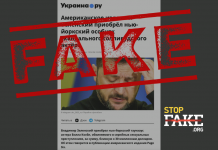The assertion that Ukraine is orchestrating a provocation involving the explosion of 550 tons of ammonia in Novotroitske is unfounded. The ammonia pipeline in that area has been out of service since 2022, with the section in the Donetsk region fully decommissioned. It no longer contains any significant quantity of ammonia, making such a scenario technically impossible.
Russia’s Ministry of Defense has launched another disinformation campaign, alleging that Ukraine is preparing a provocation involving the detonation of 550 tons of ammonia in Novotroitske. On July 17, 2025, Major General Aleksei Rtishchev, head of Russia’s Radiation, Chemical and Biological Protection Troops, claimed during a briefing that Ukrainian forces had supposedly deployed antenna-mast equipment at the site of an ammonia pipeline near the village of Novotroitske in the Donetsk region. The statement was immediately amplified by Russian state and pro-Kremlin media, including RIA Novosti, TASS, and RT.
Russia continues to propagate false narratives about alleged “chemical provocations” orchestrated by Ukraine. According to Ukraine’s Center for Strategic Communication and Information Security, these disinformation efforts are designed to discredit the Ukrainian Armed Forces, instill panic among civilians, and lay the groundwork for justifying potential Russian war crimes.
In this case, Russian propagandists once again failed to present any credible evidence to support their claims. Their narrative hinges on a purported letter from the deputy director of “Ukrhimtransamiak” to the head of the Donetsk Regional Military Administration, which allegedly labels the facility a “first-class high-risk site” and warns that “unrestricted presence of unauthorized persons on the ammonia pipeline site… poses a man-made hazard to the site, flora, fauna, and public health.” However, the letter’s image is of extremely poor quality, rendering its authenticity unverifiable. Moreover, a comparison between publicly available company documents and the version shared by Russia’s Ministry of Defense reveals major discrepancies: the document lacks a proper format and stamp, and its language is inconsistent with formal business communication. In addition, the photos included in the Russian MoD’s presentation were lifted from the official “Ukrhimtransamiak” website and do not pertain to the Donetsk region.
Moreover, the ammonia pipeline cited in the disinformation campaign has been inactive since February 24, 2022, when the Russian company Togliattiazot suspended transit operations. Despite this, the Ukrainian government allocated nearly 170 million hryvnias in 2024 to maintain the infrastructure and prevent potential “technological emergencies.” Notably, a section of the pipeline near Bakhmut was damaged in May 2022, an incident that was promptly reported by local authorities and covered by journalists. Officials clarified at the time that this particular segment had been out of operation since 2014, following the onset of active hostilities in the region, but remained under continuous monitoring by technical specialists.
Once again, the Kremlin’s propaganda apparatus is circulating falsehoods aimed at sowing panic in frontline regions and undermining Ukraine’s credibility.
Previously, StopFake debunked a false report alleging that ammonia from a pipeline, purportedly sabotaged by Ukraine, had “contaminated the positions of the Ukrainian Armed Forces.”





